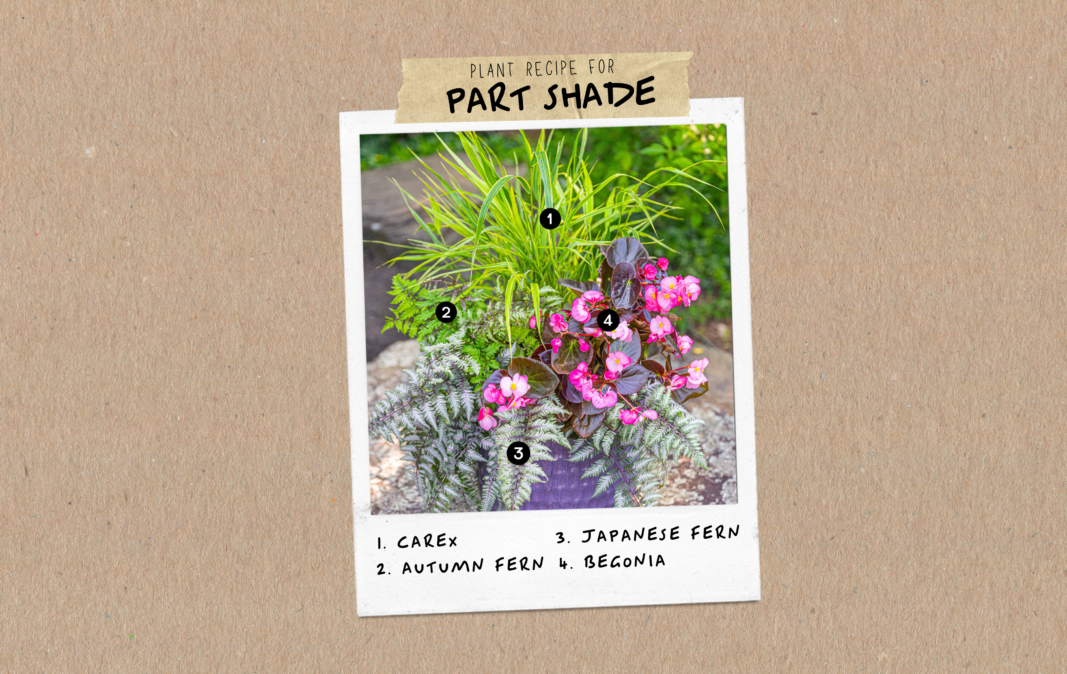 Bryn Wallace
Bryn WallaceWoodland Fern Shade Mix Container for Part Shade
Filled with texture and vibrant pops of color, this container adds whimsy and intrigue to a partly shady area of the garden. The bright pink begonia is complemented by the silvery Japanese fern foliage that boasts red veining on its fronds as it spills over the edge of the pot. The carex acts as a thrill plant that gives the container height. The airy movement of the ferns and carex make the style of this container a non-traditional woodland design with a touch of color and structure from the begonias.
Plants Featured
Carex
This ornamental, perennial grass adds height and texture to containers and garden beds. It has a compact, upright habit and will bloom short flower stalks in mid-spring to early summer. Pollinators enjoy the pollen from the flower stalks and the plant is deer resistant.
Autumn Fern
Autumn ferns add lacey texture to containers, shady bed borders and even interior spaces. When new fronds emerge, they are usually a copper-red color that turns to deep green over time.
Japanese Fern
This variegated perennial fern is silvery with dark red veins and stems, adding contrast to a container or garden bed. It is deer resistant, but rabbits may eat it. This fern has a spreading habit and could naturalize in the garden over time. If you wish to take it out of the container and move it to the garden, plant it in a place where it’ll be protected from the hottest part of the afternoon sun.
Begonia
With color options in shades of orange, pink, red, white and yellow, there are hundreds of cultivars of begonias to choose from that will bloom from summer to late fall. As an annual plant, it will not come back year after year. Deadheading begonias regularly as the blooms fade will encourage more blooms and will keep the plant looking bushy and uniform.
Planting Instructions
If you’re looking to replicate this container in your own home, follow our step by step potting instructions. Here is an abbreviated version.
1. Select a container. Choose a container with drainage holes. This allows excess water to drain out of the bottom of the pot, letting the roots take in the oxygen they need to survive. When choosing a container, consider the size of the plants you’re planning to put into it. You want to allow plenty of room for root growth. The larger the pot, the more soil you can use, meaning there is more room for growth and it is easier to keep that soil moist.
2. Add Merrifield Potting Mix. We recommend using a well draining potting soil to allow adequate moisture and oxygen balance for optimal plant health. Before you pour in your soil, place a piece of landscape fabric or a coffee filter over the drainage holes in your container. This will prevent soil from leaking out of the holes. Add Merrifield Potting Mix until the container is around ⅔ full.
3. Add a slow release fertilizer. Mix a slow release plant food, such as organic Plant Tone, into the soil. This will provide a continual release of nutrients for your plants to thrive. Follow the instructions on the bag for the amount of fertilizer to add based on the size of your container.
4. Add your plants. Before placing your plants into the soil, we suggest arranging your plants in their growers pots to see what the layout will look like when they are planted. Then, working with the tallest plant first, carex in this instance, remove the growers pot and loosen the roots, tucking the plant into your fertilized soil. Continue planting with the Autumn fern, Japanese fern and begonia in the same way. As you’re planting, you can tuck in more potting soil as you need it. The goal is to keep the soil around 1” below the lip of the container when you are finished planting.
5. Top dress your container. Use decorative rocks or mulch in a thin layer over the surface of your soil to help retain moisture, keep critters out of the soil, and keep the soil in the pot when watering.
6. Water thoroughly. After everything is planted, water thoroughly until the soil is moist and water comes out of the drainage holes of your container. If you’re placing the container on a wood surface like a deck or a balcony, we suggest using a saucer or plant toes or plant feet to keep the container lifted off of the ground so that excess water does collect under your pot and potentially damage your surface.
7. Fertilize throughout the growing season. We recommend reapplying Plant Tone two or three times during the growing season, pouring it directly on top of the soil. If you’re using a decorative soil cover, push it aside to place the Plant Tone directly on the soil surface. Follow the instructions on the bag for the amount to apply for continual feeding.
Ongoing Care
Watering
The plants in this container will thrive with moist soil. You do not want the soil to completely dry out or remain soaking wet. In general, you will likely need to check the soil for water every 1 to 2 days. Use your finger to reach into the soil a few inches deep and feel if the soil is wet or dry. If the soil is beginning to dry out, water thoroughly until the soil is totally saturated and feels like a soaking wet sponge and water runs through the drainage holes of the container.
Overwintering
If you’re planting in a high quality planter, such as wood, well-fired ceramics or frost resistant terracotta, your plants will likely overwinter just fine, provided the pot is elevated off the ground using plant toes or plant feet to prevent water from collecting and cracking the pot. If we’re expecting severe winter weather in our area, we recommend wrapping the container in bubble wrap and burlap or insulating a group of containers in mulch to provide extra root protection.



